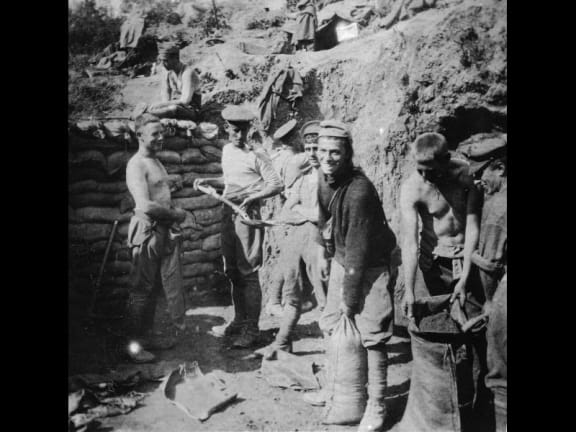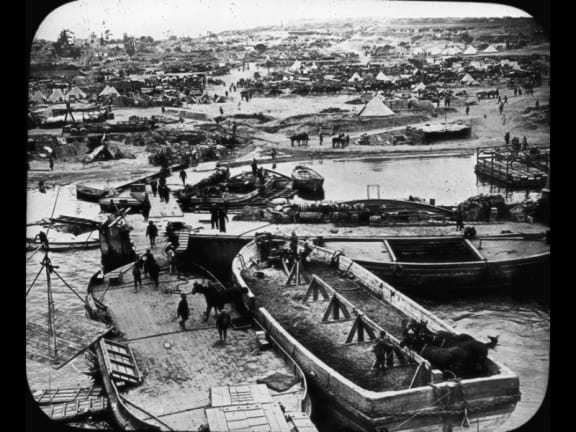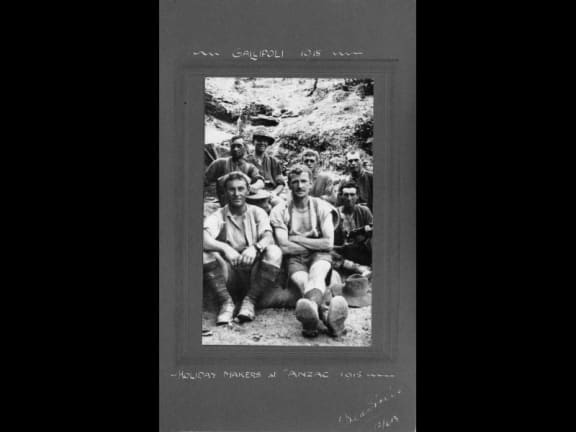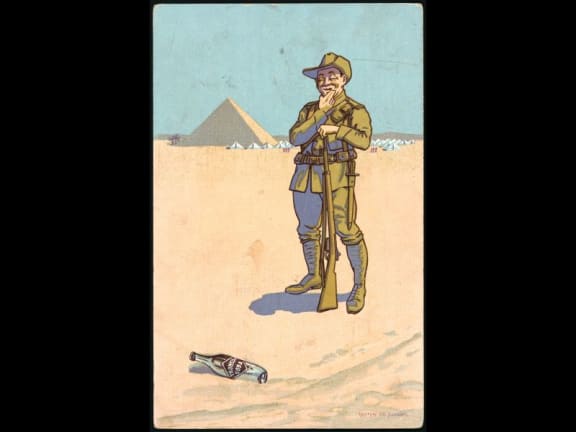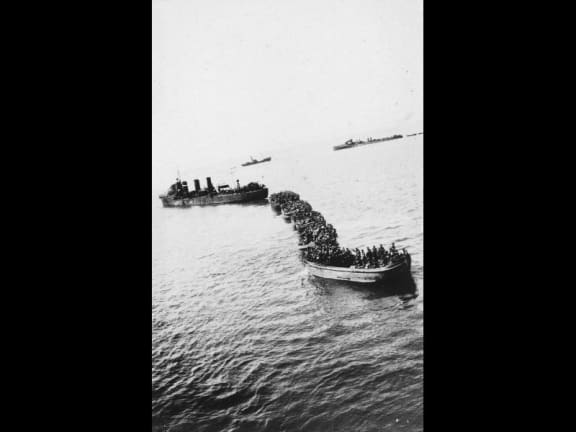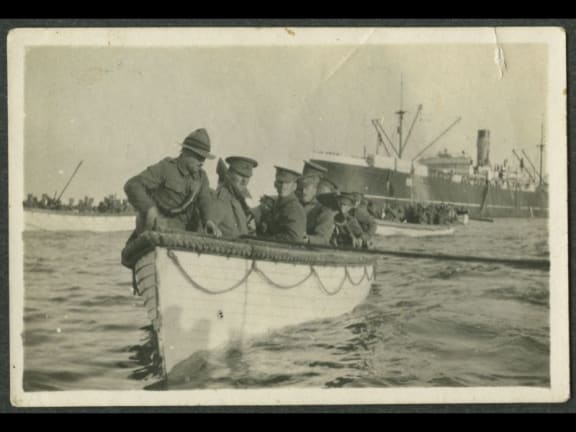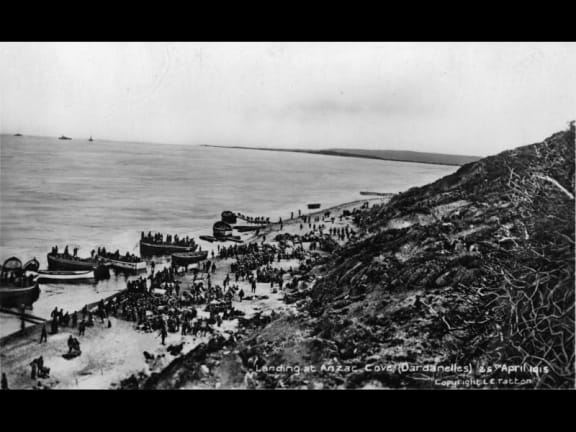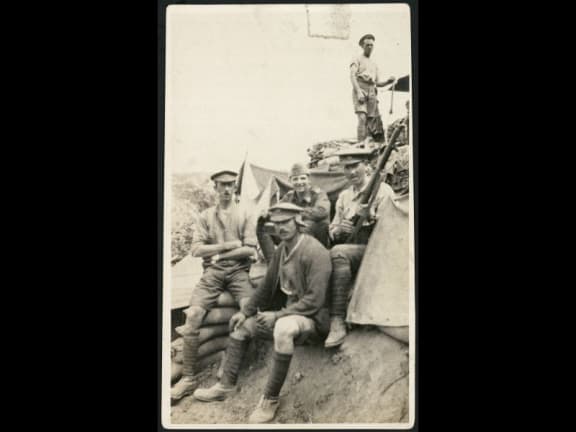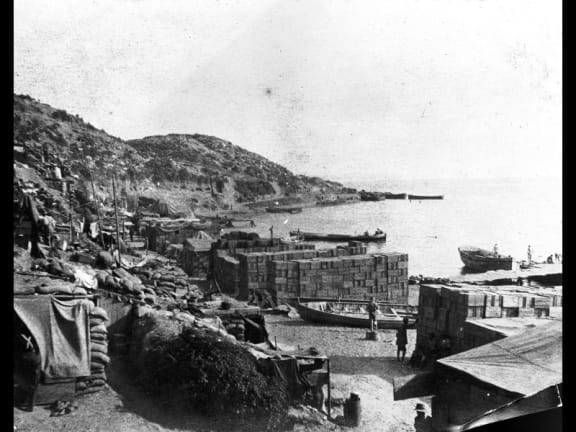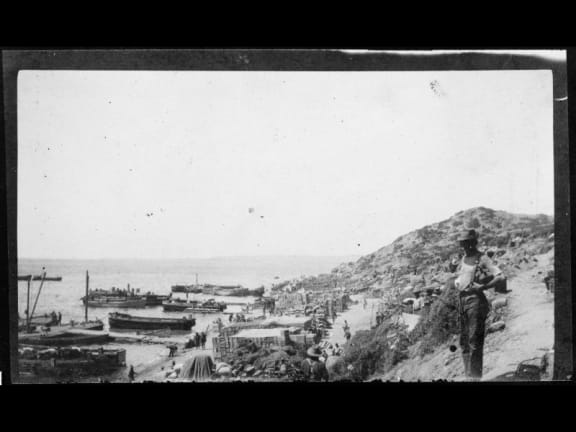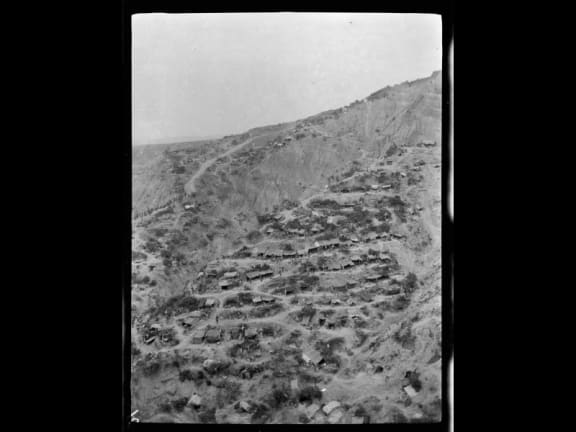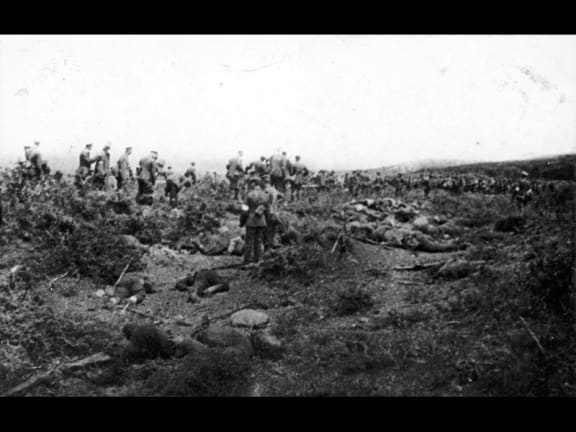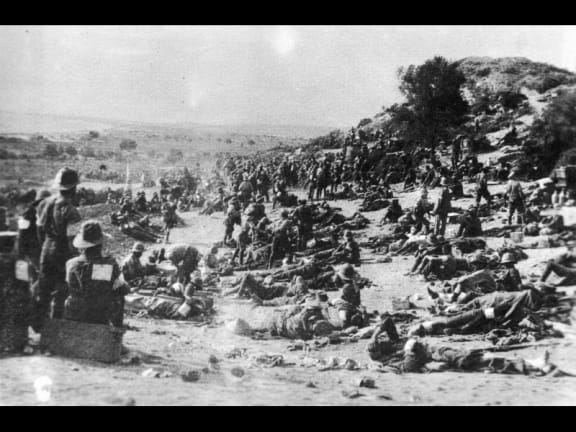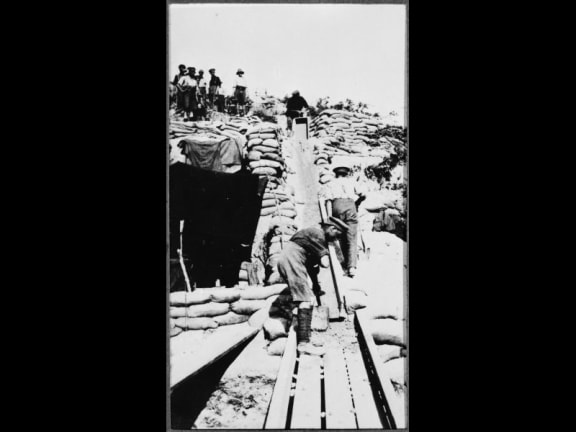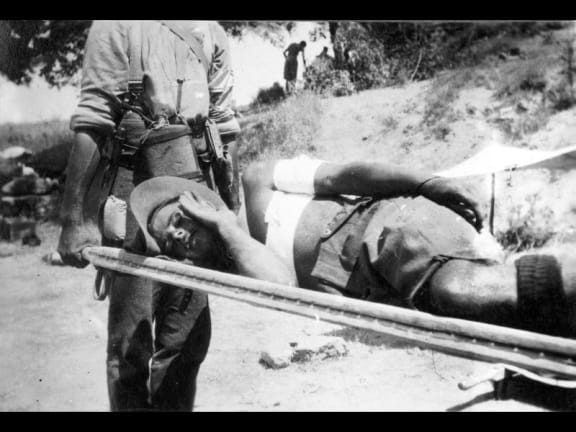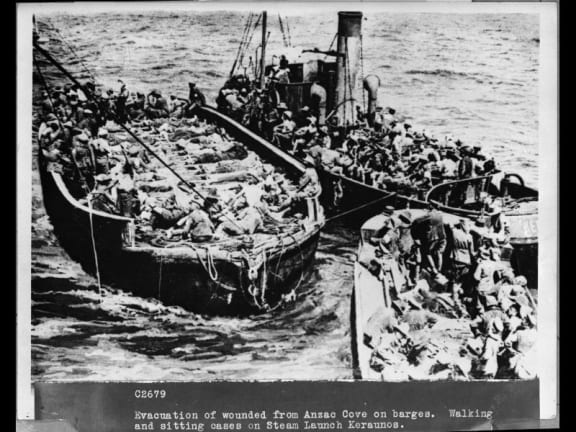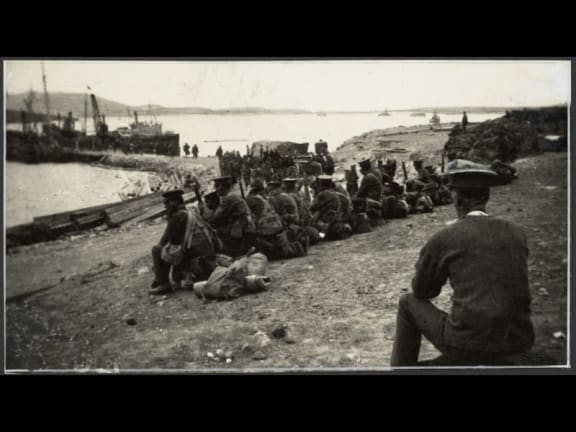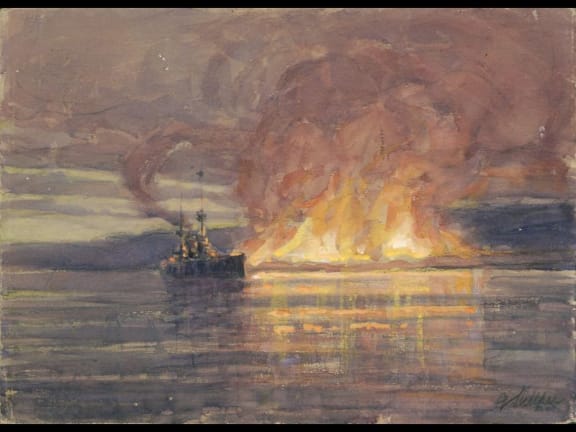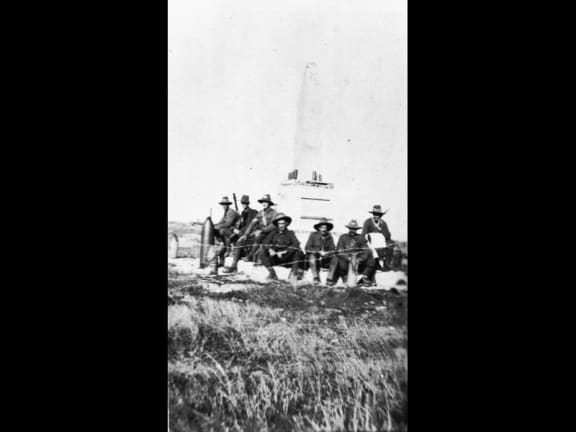
New Zealand soldiers, Gallipoli, Turkey. The group includes Geoff Barnett, James Hutcheson, and Bucket Bell. Photo: Alexander Turnbull Library Ref: PA1-o-573-27-2.
"Real courage isn't just an act of daring, it's carrying on. That's what the Anzacs did. We may express tribute in stone to their memory, but it is their spirit that will endure even longer in history. Their names liveth for evermore"
- Ngā Taonga Sound & Vision ID 33025 Return to Gallipoli: talk by C. R. Bassett, 11 Apr 1949.
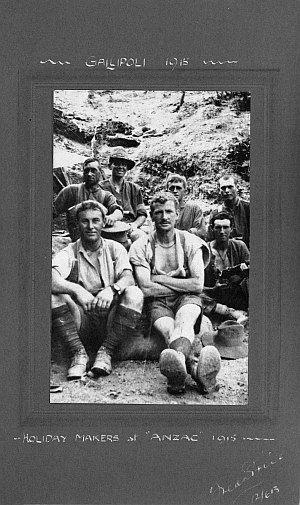 For many New Zealanders, Gallipoli was to be the biggest adventure of their lives. To them fighting for King and Country was a calling and an honour, fresh-faced young men with glory in their eyes set sail to cross the world. An adventure indeed, and one that would cost many of them their lives.
For many New Zealanders, Gallipoli was to be the biggest adventure of their lives. To them fighting for King and Country was a calling and an honour, fresh-faced young men with glory in their eyes set sail to cross the world. An adventure indeed, and one that would cost many of them their lives.
Members of the New Zealand Expeditionary Force expected to head for France and the Western Front. Instead, to general disappointment they disembarked in Egypt. After months of training in the desert around Zeitoun Camp near Cairo, the Australian and New Zealand troops (Anzacs) were again loaded aboard ship and headed for Gallipoli.
On April 25th 1915, as early as 1am, troops on the ships were fed, watered and mustered into companies as they prepared in silence for night to make its transition into dawn. Waiting for the landing was the calm before the storm. Recent British bombardment of the coast had given the Turkish forces ample warning to prepare for the attack, and so they also sat and waited, watching the incoming ships and vessels from the overlooking hills. Just after 4am the Anzacs began to make their way onto land against unexpected heavy fire.
Laurie Smith: "The first lot of the Wellington Battalion to land were the Headquarters plus the Taranakis and we clambered down the side of this boat onto these barges and took our places with packs that weighed eighty-seven pounds, we were towed well into shore and then left to our own devices. And as we came in, of course the Turks had got their artillery, by that time, into position and they were letting us have it and, strange to say, on the barge that I was on there was only two casualties and they weren't very bad…We got ashore but when the fellows took off their packs, some of them were astounded to find that their packs were full of the shrapnel pellets."
- Ngā Taonga Sound & Vision ID 40093
Pat Lloyd: Oh, well we came off this transport, the Itonus. Got down ladders. Oh, I should say we were told to drink water, that would be the only thing we'd be short of. We were walking round and round the water taps on the ship, piling water into us for hours. Then we got down these ladders into a little pinnace, and then into ships' boats and we were taken to within, oh, within, as close in as they could get and then got out and waded ashore."
Interviewer: "You'd be under constant fire?"
Pat Lloyd: "Yes, under fire. Not as much fire as you would have imagined, but they were, there were casualties taking place all the time. As a matter of fact, I saw, not that day, but later on, one of these boatloads of fellows, and they must have got them with a machine-gun, and it was just full of congealed blood and bodies. There must have been thirty of them, dead where they sat. It was a queer-looking sight, to see this boatload of corpses and the congealed blood, just like a jelly, full of dead."
- Ngā Taonga Sound & Vision ID 27762
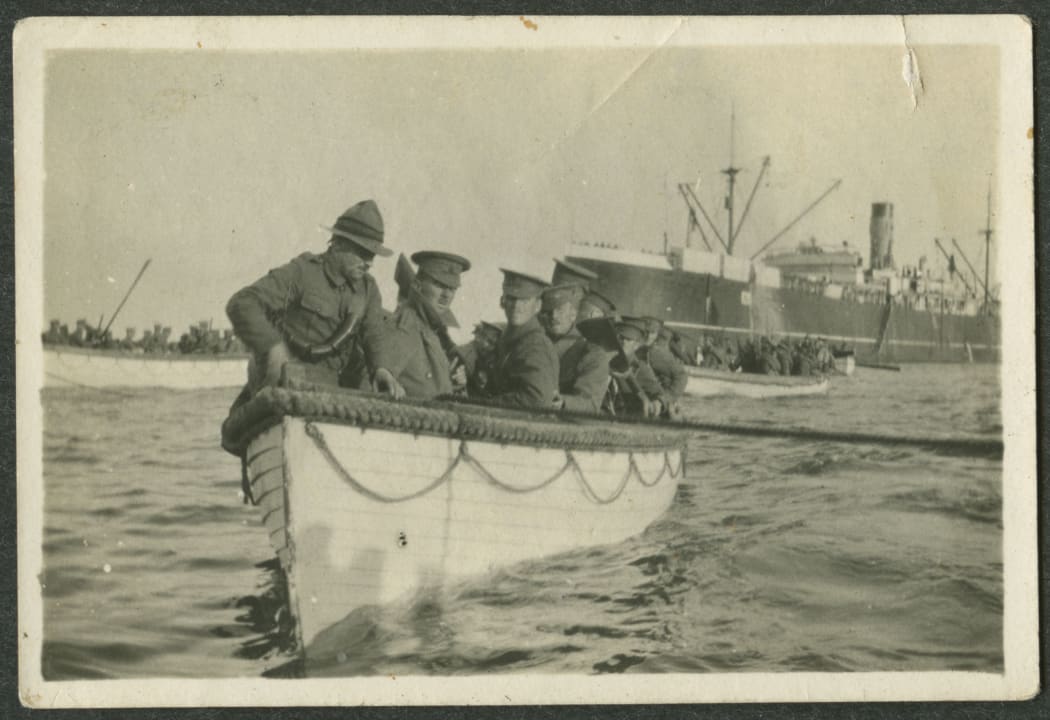
Boatload of New Zealand soldiers heading for Gaba Tepe, Gallipoli, Turkey. Photo: Alexander Turnbull Library Ref: PAColl-0914-1-12-2.
Laurie Smith: "One part of our men broke and ran and, ah, well it's the first time, it was the first time I'd ever seen men in a panic and I knew then that men can be just ruddy cattle for they trod on the dead and the wounded and anybody else that got in the road. If it hadn't've been for Hart, Major Hart, Steve we called him, but that wasn't him, Bert Hart, he was a major, a second in command. I can see him now stopping that rot. He stopped them, he stopped them with the point of a revolver. It's only a ridge you see, they were running down and he said, "Where are you going? he said "You're none of you, not all of you are good swimmers, you won't all get away. Now you might just as well come back and take your place in the line. Now come on". And with one accord, they were just like sheep, back they went …”
- Ngā Taonga Sound & Vision ID 40093
The landing on what is now known as Anzac Cove has seared itself on the New Zealand collective memory, but on the day itself the focus was on survival.
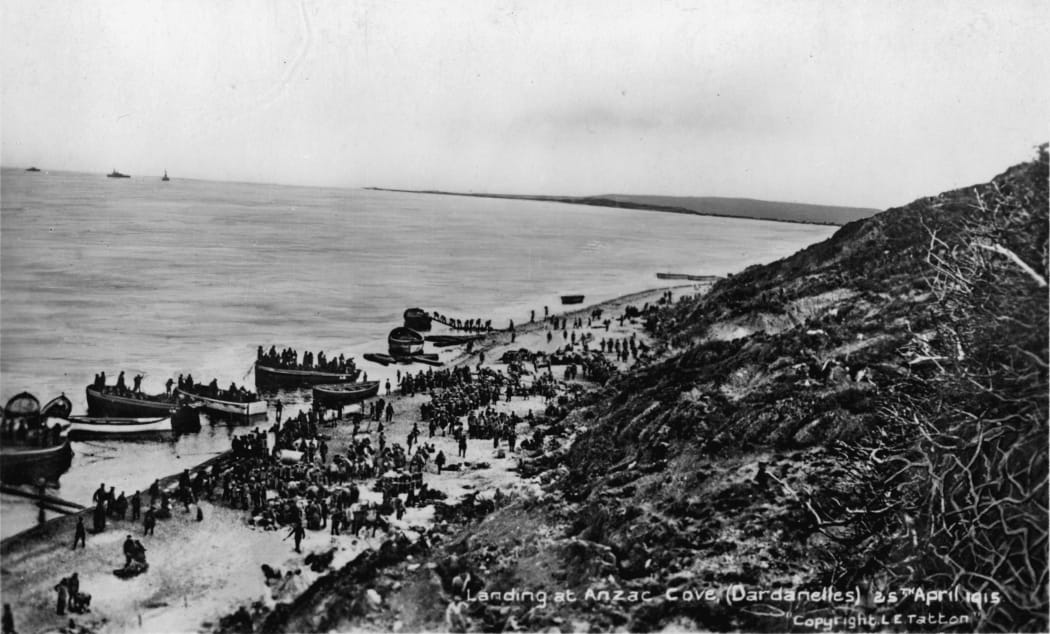
Landing at Anzac Cove, Gallipoli Photo: Alexander Turnbull Library Ref: PAColl-0063-03.
Jim Meek: Well, they say only dirty people wash, and we were the dirty men who didn't wash at all, practically. Fresh water was too precious to use for washing. A man thought himself lucky if he got enough to drink. most chaps would have a Turkish bath of sorts by drinking hot tea when they had it some hot afternoon and then when they sweated, wiping dirt and sweat away in the one operation with a piece of rag. About the middle of June of course, day bathing at the beach was prohibited. Too many chaps were being wounded or killed by the shrapnel fire and men were often too weary to plod down to the beach at night time for a dip. Some chaps let their whiskers grow. Quite a good idea, it helped to camouflage us and our features which were becoming gaunter and gaunter as the grim days and nights put their mark on us all.
- Ngā Taonga Sound & Vision ID 150043
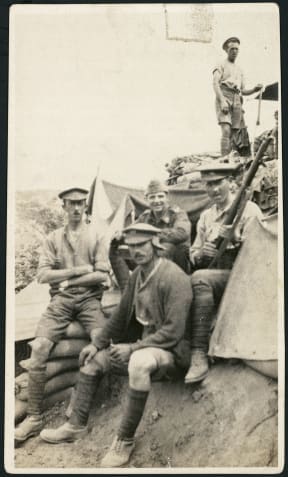
Group of New Zealand soldiers, Gallipoli Peninsula, Turkey. Photo: Alexander Turnbull Library Ref: PA1-o-666-26
After the shocking casualties of landing day, for those who made it ashore, life settled into a routine of crushing boredom mixed with the sickening exhilaration of dangerous sorties and charges. The monotony of trench digging and lookout duty and flies and lice, dust and heat, or cold and mud, lack of decent tucker and unsure water supplies was made worse by constant shelling and sniping from the Turks.
Jim Meek: "Nothing was easy to do, so nothing was easy to forget. Everything was difficult to do and so difficult to forget. Let me see how many jobs I can remember: barbed wire entanglements, bomb-deflecting screens out in front, overhead cover on the frontline trench, snipers' possies facing Dead Man's Ridge - or as it was sometimes called No Man's Ridge, steps up the steepest of the saps where the clay had been pounded to dust, loopholes in the frontline parapet with some iron or steel loophole plates added later, recesses in the frontline for additional riflemen, an emergency machine gun possie on top of a long shaft tunnelled up through the ridge on the right of the position with a tiny aperture for seeing and firing down on the Turks position if ever they should decide to advance against Quinn's. Sandbag barricades on tracks leading up to Quinn's, additional deviation saps in case those generally in use were blocked during an attack, counter-mining underneath the Turks' mines and underneath the Turks' trenches, restoring frontline clay parapets that had been shot, of course to dust, with bags of shingle lumped by the Diggers all the way from the beach. Then we put up bridge barricades across the approaches to the Post to block the spent machine gun fire of the Turks. We established pits for home-made trench mortars. We supplied periscopes and periscope rifles to the boys in the frontline. We established dumps where emergency tools and materials could be had as soon as required by the garrison of Quinn's."
- Ngā Taonga Sound & Vision ID 150043
On the 24th of May, with heavy casualties and the hot sun beating down on rotting corpses, the stench of death permeating the surrounding trenches, with increasingly poor sanitation and rising cases of dysentery and typhoid, an urgent 24 hour ceasefire was agreed to clear away the dead on both sides.
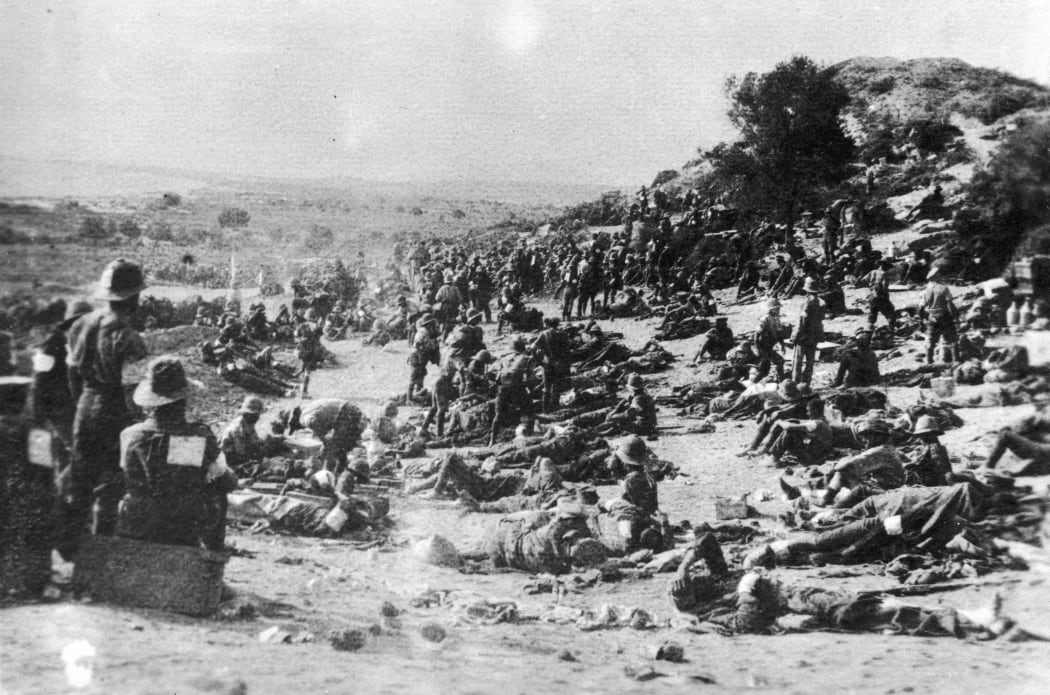
Wounded soldiers lying on a rise between North Beach - later site of Commonwealth War Graves Commission (CWGC) Canterbury Cemetery, near Anzac Cove, Gallipoli, Turkey. Photo: Alexander Turnbull Library Ref: PA1-o-863-03-5
Bob: "The doctors, they couldn't handle it, see? I wouldn't be dead sure about these figures, but I have an idea, I think there was 120,000 cases of sickness against 90,000 casualties. Bowel trouble, dysentery and diarrhoea and all that. That was the flies. Look, I'll tell you this: conditions got that bad, May... I'm just not that sure of the date. May the 2nd or May the 8th, a Turkish officer come over their front line with a white flag up. He crossed no-man's land. He was taken and blindfolded at our front line down to the beach to Headquarters to jack up an armistice to bury the dead. The smell, my friend, you've never smelt anything in your life like it. It got to that stage that neither the Turks or us could bear the smell of the dead in no-man's land. I was back in the trench, watch out, waiting for four o'clock. Four o'clock, bang - the first shot was fired. I don't know where it was, whether it was theirs or ours, but I heard a rifle shot; the war was on again."
- Ngā Taonga Sound & Vision ID 24526
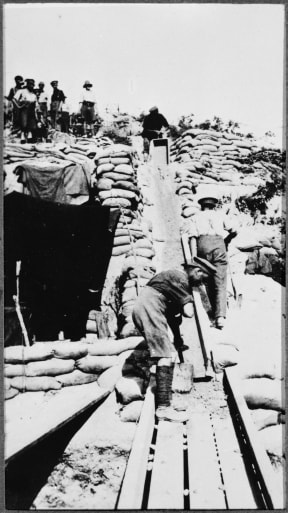
Mining at Quinn's Post, Gallipoli. Hampton, W A. Photo: Alexander Turnbull Library. Ref: 1/2-168806-F.
Quinn’s Post was renowned as the extreme front of the front line at Gallipoli, under constant attack and sniper fire. Even under such strenuous conditions the New Zealand and Australian sense of humour would occasionally make itself known, as Colonel JG Hughes recalls in a momentous occasion on Pope’s Hill.
Colonel John Hughes: "After a few weeks it was noticed the enemy was much more sparing in his use of ammunition. It was arranged for a sham attacks to make the Johnny Turks get rid of more ammunition. I had just taken over command of the regiment. Colonel Hughes was the 4th commanding officer since the landing. My General told me I must do something to encourage the enemy to waste ammunition. I went into the matter with my adjutant, Captain Critchley-Salmonsen and they arranged for flares and bugles the following night. Nothing worked until the men gave a British cheer. The result was amazing. The cheer was taken up by the troops on our right, at Pope’s Hill and Courtney’s Post, right along to the Australians at Lone Pine. Along our left to Walker’s Ridge where the Mounted men let go. Behind the artillery on Plugge’s Plateau and right down to the beach. Each poor tired unit in turn cheering because they thought our cheer could only mean good news being given to us. The whole Turkish Army along the different fronts went mad and blazed away for nearly half an hour, hitherto unknown gun positions gave their secrets away...We at Quinn's Post were hugely delighted and yelled with laughter. We rolled in the trenches, slapping each other on the back in our joy, the very next day we were visited congratulated next day by several commanders including Birdwood and Godley and were mentioned in general orders.
"There wasn’t much fun on Gallipoli, as you may easily believe but this was a joke and one of the very few."
- Ngā Taonga Sound & Vision ID 32682

Group of New Zealand soldiers, Gallipoli Peninsula, Turkey. Photo: Alexander Turnbull Library Ref: PA1-o-666-26
There was no doubt that the odds were against Anzacs. The Turks knew the lay of the land and were defending their own country, not fighting in a hostile land far away from home. The battle of Chunuk Bair and Hill 60 were no exception.
Ernest Harston: "Our biggest show, for the New Zealanders, and particularly for the Wellington Battalion, to which I belonged, was Chunuk Bair. We went out from Anzac and hid in a valley between our own outposts. Then we went up the next night past Number 2 and Number 3 Outpost and up the long dere towards The Apex. It's an old story, you've all heard it hundreds of times no doubt, and then there was this rush to the top of Chunuk Bair, which we took almost without a shot, certainly without a shot being fired at us, but then of course once we got there, hell broke loose and we were enfiladed from higher ground further on our left. We held it all day. The Mounted Rifles and the rest of the New Zealanders and two, four of the English battalions also came up from reserve and helped hold the crest but eventually the Turks, probably under Enver himself, came over the hill just before dawn. Nobody knew whether they were Turks or New Zealanders- from the beach they couldn't tell. And eventually it looked as if we were going to be completely surrounded and everything of that kind. They were coming down the hill with old Enver, they say it was Enver, on the top, waving them forward with his sword, when suddenly our artillery opened up, and you never saw such slaughter in your life. It was a whole flat hillside and the broadsides from the ships and the fire from the guns went straight into them." - Ngā Taonga Sound & Vision ID 150043

A scene on Armistice Day, May 24 1915, in front of the New Zealand Mounted Rifles at the Nek, Gallipoli, Turkey. Armistice day, Gallipoli, Turkey. Photo: Alexander Turnbull Library Ref: PA1-o-811-23-3.
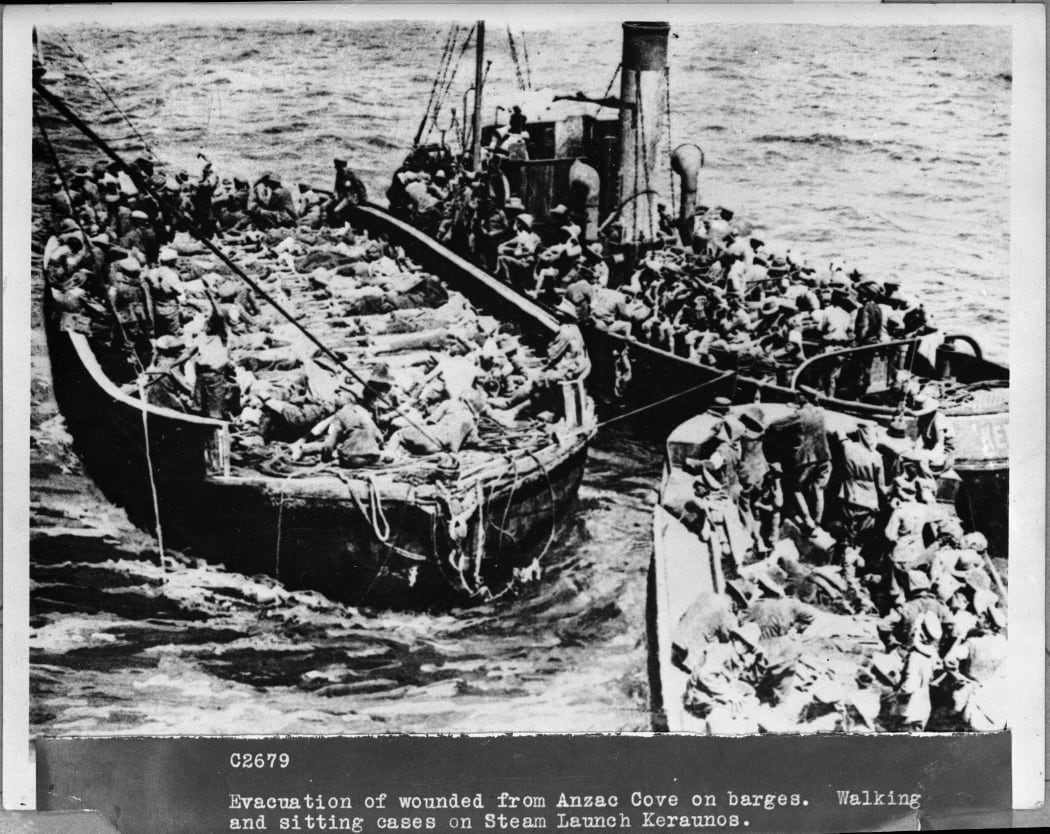
Evacuation of the wounded from Anzac Cove. Photo: Alexander Turnbull Library Ref: 1/4-008784-F
For the men at Gallipoli the daily reality was one of hardship, loss and often brutally narrow escapes. Injury and sickness were constant occurrences.
Veteran: "Well, I just got one through the knee. Quite a simple one but it blew my knee to pieces and that was that. I was carried back by Phil Blake. He carried me back down to the dressing station over his shoulders, like a half side of beef [laughs]. I think he carried me back about three miles that way down to the dressing station That’s a heavy weight to carry for three miles. Plonked me down at the dressing station and that was that. Then a couple of days later I went down to the beach on a stretcher. I arrived on the beach and the stretcher bearer said they‘ve got a very sick man, would I lend him my stretcher? And I said “Yes take it”. He said “We’ll get you another one as soon as we can.” And I lay down on the stones. And the stones were about this big and I had stones for a pillow and stones sticking into my back and my heels. I lay there for 24 hours. That was the worst experience I had, 24 hours lying on stones. And the only pain I had was in the front, no pain in the back, but the pain in the front was nearly driving me crazy." - Ngā Taonga Sound & Vision ID 257106
Then it was time to go. In an evacuation well planned and executed, the Anzacs left under cover of night. The campaign was a failure, but long to be remembered, by those who were there, and those who came after them.
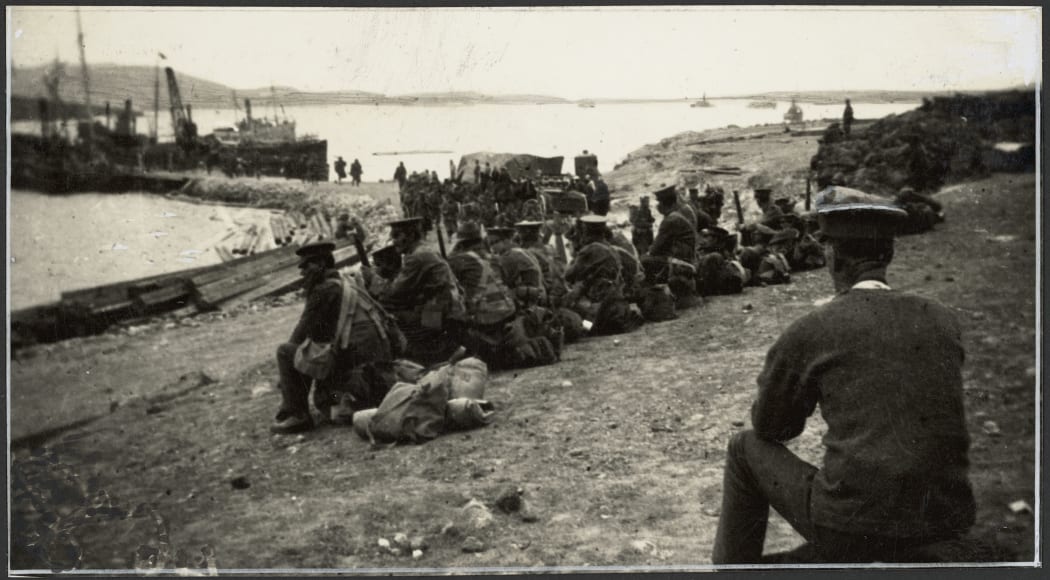
Canterbury Mounted Rifles upon landing at Mudros. Photo: Alexander Turnbull Library Ref: PA1-o-811-26-3.
Veteran: "But we left a lot of booby traps behind us. We left booby traps in the form of bombs with the pin drawn and wrapped up in a blanket so they couldn't explode until they were disturbed. We left, bombs, grenades, all types in brackets in the trenches and we left, anything we could devise in the way of a way of a booby trap we left behind for them to get a bit of a surprise and something, give them some interest. And there was a small knot of men assembled, waiting to get onto their lighters and go out to the ship. The Engineers of course were entrusted with the job of pressing the double button and setting up the mines which were charged with all the explosives that we could possibly muster. There must have been many hundreds of tons of explosives left behind, mined by the tunnellers under the Turkish trenches, and it was the Engineers' job to press the button and blow them up as they stepped into their boat. That was the last of Gallipoli." - Ngā Taonga Sound & Vision ID 255956
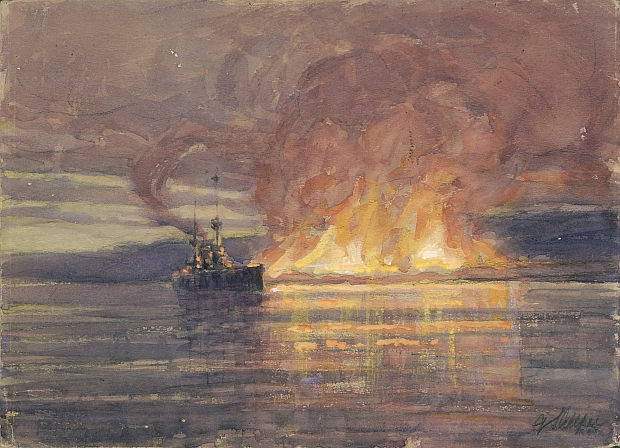
[The evacuation of Suvla Bay. The burning of a million pounds worth of stores; last lighter [sic] coming away as dawn broke] 1915. Allfree, Geoffrey Stephen, 1889-1918. Allfree, Geoffrey S, 1889-1918 : Ref: A-176-003. Alexander Turnbull Library, Wellington, New Zealand.
Veterans have returned to Gallipoli over the years, to remember the friends they lost, and the men they fought against. Gallipoli veteran and Victoria Cross winner Cyril Bassett recorded a talk in 1949 for the New Zealand Broadcasting Service called Return to Gallipoli (available here in full from Nga Taonga Sound & Vision) which sums up New Zealanders’ complex responses to the events of Gallipoli
Return to Gallipoli : talk by C. R. Bassett.
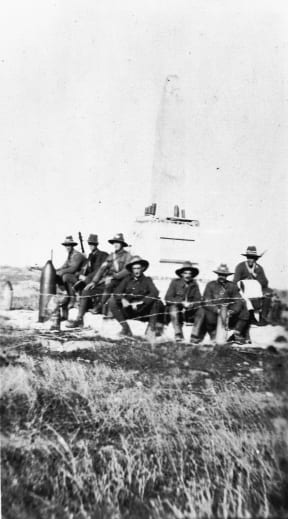
Unidentified group of veterans alongside Lone Pine Memorial, Gallipoli peninsula, Turkey, photographed when the Canterbury Mounted Rifles returned in December, 1918. Photo: Alexander Turnbull Library Ref: PA1-o-169-21-2
11 April 1949
"Just before the dawn on Anzac Day a year ago, I stood on the beach cemetery south of Anzac Cove on Gallipoli. Always since Gallipoli days long ago, I have dreamed of returning but in those dreams I had scarcely dared to hope that the actual chance to do so would ever come. And now I was back. Back again, representing New Zealand ……
"That day of pilgrimage to me seemed unreal. I stood among men who once had been our mortal foes. We had hated them but had never despised them. We had admired their stubborn gallantry, their capacity to endure. They're such a race loyal to themselves and their country we had become friends again. They have the solid qualities, on which friendship, real friendship that is, is founded. Between us laid a bond of mutual respect. Our dead had mingled and then our mutual homage I think we gained a lot that day. I think that visit paved further the paths of understanding, deepened national friendship and we left with deep admiration for those men of the Imperial War Graves Commission who have carried out that vast work of commemorating our dead and the dead of our allies in thirty-two war cemeteries. The spirit of Anzac has become a tradition; the name of Anzac symbolises our memory of all our dead in two great wars. In that August fighting on Gallipoli which became the culmination of all fury, many of our men were so weak of body because of privations that today seem incredible, that they stumbled or fell as they pressed forward. Real courage isn't just an act of daring, it's carrying on. That's what the Anzacs did. We may express tribute in stone to their memory, but it is their spirit that will endure even longer in history. Their names liveth for evermore".
Ngā Taonga Sound & Vision ID33025
Return to Gallipoli: talk by C. R. Bassett, 11 Apr 1949.
Related stories:
Thanks and credits
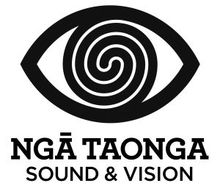 Transcript and archival audio supplied by Nga Taonga Sound and Vision.
Transcript and archival audio supplied by Nga Taonga Sound and Vision.
Images from the Alexander Turnbull Library Collection
Web Content: Emma Hart
Additional voices and readings: ‘Bright letter from Gus’ read by: Adrian Mackenzie as Mr W.A. Harte and Jono Regan as Sergeant W.A Gustafson; Voice of naval officer - Howard Sly.
